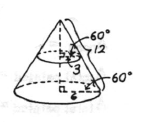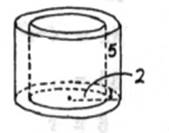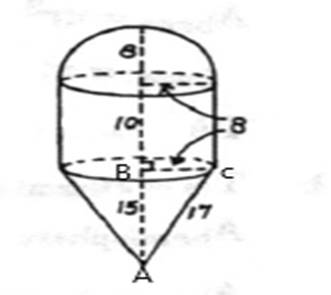
Concept explainers
a.
To calculate: The total area of a cone frustum if slant height is 5.
a.
Answer to Problem 14PSC
The total area of frustum is
Explanation of Solution
Given information:
Radius of top base = 3,
Radius of bottom base = 6,
Formula used:
Area of cone
C = Circumference of cone and l = slant height of cone
r = radius of
Area of a circle:
r = radius of circle
Calculation:

The surface forms frustum of a cone. Extend the frustum to form a cone’
There are two
In large
The converse of Midline theorem is used. Midline theorem states that the segment that joins the midpoints of two sides of a triangle is parallel to the third side and half as long
In small triangle, hypotenuse
Circumference of top cone:
Lateral Area of top cone
Lateral Area of top cone
Lateral Area of top cone
Circumference of bottom cone:
Lateral Area of bottom cone
Lateral Area of bottom cone
Lateral Area of bottom cone
Difference in Lateral Area
Area of top base circle
Area of bottom base circle
Total Area = Area of bottom base circle + Area of top base circle + Difference in Lateral Area
Total Area
Total Area
b.
To find: The total area of a cylindrical shell with height as 5.
b.
Answer to Problem 14PSC
The total area of cylindrical shell is
Explanation of Solution
Given information:
Radius of smaller circle = 2,
Height of cylinder = 5.
Formula used:
Area of cylinder
C = Circumference of cylinder and h = height of cylinder
Area of a circle:
r = radius of circle
Calculation:

The surface forms cylindrical shell.
Radius of smaller circle = 2
Radius of larger circle
Height of cylinder = 5.
Circumference of larger cylinder:
Lateral Area of larger cylinder
Lateral Area of larger cylinder
Lateral Area of larger cylinder
Circumference of smaller cylinder:
Lateral Area of smaller cylinder
Lateral Area of smaller cylinder
Lateral Area of smaller cylinder
Area of larger circle
Area of smaller circle
Total Area = Area of larger cylinder + Area of smaller cylinder + 2(Area of larger circle - Area of smaller circle)
Total Area
Total Area
Total Area
c.
To calculate: The total area of a
c.
Answer to Problem 14PSC
The total area of solid is
Explanation of Solution
Given information:
Radius = 8,
Height of cylinder = 10,
Slant height of cone = 17.
Formula used:
The below theorem is used:
Pythagoras theorem states that “In a right angled triangle, the square of the hypotenuse side is equal to the sum of squares of the other two sides”.

In right angle triangle,
Area of cylinder
C = Circumference of cylinder and h = height of cylinder
Area of cone
C = Circumference of cone and l = slant height of cone
Area of hemisphere
r = radius of hemisphere
Calculation:

Side AB can be calculated by applying Pythagoras Theorem.
In right angled triangle ABC , we get
Height of cone
Slant height of cone = 17.
Height of cylinder
Area of cylinder
Area of cylinder
Area of cylinder
Area of cone
Area of cone
Area of cone
Area of cone
Area of hemisphere
Area of hemisphere
Area of hemisphere
Total Area = Area of cylinder + Area of cone + Area of hemisphere
Total Area
Total Area
Chapter 12 Solutions
Geometry For Enjoyment And Challenge
Additional Math Textbook Solutions
A Problem Solving Approach To Mathematics For Elementary School Teachers (13th Edition)
Elementary Statistics
Elementary Statistics: Picturing the World (7th Edition)
Elementary Statistics (13th Edition)
A First Course in Probability (10th Edition)
Intro Stats, Books a la Carte Edition (5th Edition)
- Can someone help me with this please?arrow_forwardMariela is in her classroom and looking out of a window at a tree, which is 20 feet away. Mariela’s line of sight to the top of the tree creates a 42° angle of elevation, and her line of sight to the base of the tree creates a 31° angle of depression. What is the height of the tree, rounded to the nearest foot? Be sure to show your work to explain how you got your answer.arrow_forward1arrow_forward
 Elementary Geometry For College Students, 7eGeometryISBN:9781337614085Author:Alexander, Daniel C.; Koeberlein, Geralyn M.Publisher:Cengage,
Elementary Geometry For College Students, 7eGeometryISBN:9781337614085Author:Alexander, Daniel C.; Koeberlein, Geralyn M.Publisher:Cengage, Elementary Geometry for College StudentsGeometryISBN:9781285195698Author:Daniel C. Alexander, Geralyn M. KoeberleinPublisher:Cengage Learning
Elementary Geometry for College StudentsGeometryISBN:9781285195698Author:Daniel C. Alexander, Geralyn M. KoeberleinPublisher:Cengage Learning

